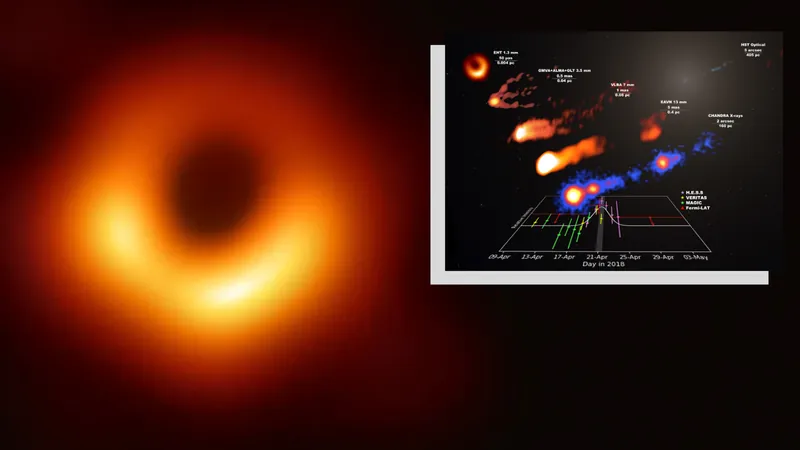
Breakthrough Discovery: The First-Ever Image of a Monster Black Hole Ignites a Gamma-Ray Explosion!
2024-12-16
Author: Arjun
Historic Revelation of a Black Hole Image
In a historic revelation in 2018, scientists unveiled the first-ever image of a black hole—an astonishing feat achieved by the Earth-sized Event Horizon Telescope (EHT). Now, that same telescope has made headlines again by witnessing a powerful and unexpected gamma-ray explosion from the supermassive black hole known as M87*, located about 55 million light-years away at the center of the galaxy M87.
Details of the Gamma-Ray Explosion
The explosive flare—lasting approximately three days in late April and early May 2018—marked the first recorded outburst from M87* since 2010, and its intensity surpassed typical flares produced by this remarkable cosmic entity. High-energy gamma rays emitted during this event provided a unique opportunity for scientists to theorize about the complex structures surrounding supermassive black holes and the dynamics of their jets.
Comparing Supermassive Black Holes
M87* dwarfs our galaxy's own supermassive black hole, Sagittarius A* (Sgr A*), boasting a mass roughly 5.4 billion times that of our Sun compared to Sgr A*’s estimated 4.3 million solar masses. While Sgr A* remains relatively quiescent, M87* actively feeds on nearby matter, resulting in intense jets that can produce high-energy emissions like the gamma-ray eruption observed by the EHT.
Scientific Implications of the Discovery
"With these new observations, we have an unprecedented chance to explore the gamma-ray emission region and its relation to the surrounding jet of M87*. This could enable us to answer some of the biggest questions in astrophysics," stated Giacomo Principe, project leader and researcher from the University of Trieste. Questions are circulating in the scientific community, including how relativistic jets form, what accelerates the particles responsible for gamma ray emissions, and the origins of cosmic rays detected on Earth.
Understanding the Environment of Black Holes
A captivating aspect of supermassive black holes like M87* is the chaotic environment in which they exist. Surrounded by an accretion disk, matter spirals around, gradually feeding the black hole. Surprisingly, much of this matter is flung away due to the black hole's voracious appetite and the powerful magnetic fields that channel material toward its poles. These interactions give rise to energetic jets that stretch thousands of light-years into space, dwarfing the size of the black hole itself—imagine a blue whale erupting from a single bacterium!
The Interplay of Jets and Event Horizon
The interplay between these energetic jets and the event horizon of M87* offers tantalizing clues about the complex nature of black holes. Notably, the recent observations have revealed changing angles of these jets and potential connections to the black hole's event horizon, suggesting a dynamic relationship that shapes our understanding of these massive cosmic objects.
Collaborative Efforts and Future Research
In a monumental collaborative effort, the EHT combined observations with various space-based instruments, including Fermi, NuSTAR, Chandra, and Swift. The joint data collection enabled scientists to detail the gamma-ray emission and its correlation with brightness variations measured at different wavelengths, further highlighting the necessity of coordinated multi-wavelength approaches for studying celestial phenomena.
Conclusion and Future Prospects
Thanks to this groundbreaking research, questions that have perplexed scientists for decades can now begin to be addressed, allowing us to unlock the mysteries behind the functioning of supermassive black holes and the enigmatic jets they produce.
Stay tuned for more updates as astronomers continue to decode the secrets of the universe! Could this breakthrough help us understand the origins of cosmic rays? What revelations lie ahead in the vast, uncharted expanse of space?





 Brasil (PT)
Brasil (PT)
 Canada (EN)
Canada (EN)
 Chile (ES)
Chile (ES)
 España (ES)
España (ES)
 France (FR)
France (FR)
 Hong Kong (EN)
Hong Kong (EN)
 Italia (IT)
Italia (IT)
 日本 (JA)
日本 (JA)
 Magyarország (HU)
Magyarország (HU)
 Norge (NO)
Norge (NO)
 Polska (PL)
Polska (PL)
 Schweiz (DE)
Schweiz (DE)
 Singapore (EN)
Singapore (EN)
 Sverige (SV)
Sverige (SV)
 Suomi (FI)
Suomi (FI)
 Türkiye (TR)
Türkiye (TR)